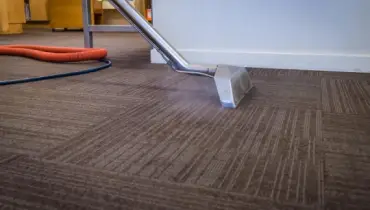
Rainbow Restoration highlights essential steps to prevent mold growth in wet carpets, ensuring a healthy indoor environment:
|
Seasonal storms can uproot plants, damage vehicles, and even cause leaks inside of your home. But you don’t have to have a flooded home to get a wet carpet. Even water from a plumbing leak, a burst water heater, or even an overflowing bathtub can cause water to saturate your carpet. If your carpet gets wet, there is a risk of mold developing. A call to professional carpet cleaners and mold remediation specialists is your best form of flooded carpet mold prevention. But knowing how to prevent mold in carpet that is wet can be an important step to ensuring you and your family stay safe until they arrive. There are several things you can do to help minimize the chance of mold and mildew developing.
Speed is the Key
Mold and mildew can form very quickly—all it takes is moisture, darkness, and poor air circulation. If the leak occurs during warm weather, mold will grow even faster. In fact, in warm weather mold can start growing just 24–48 hours after the moisture penetrates your carpet. To prevent mold in carpet, take the following steps as soon as you notice a wet carpet:
-
Cut off the water source.
If spilled water it the culprit (overflowing bathtub, fish tank spill, etc.) just make sure no more water is released. If an appliance or fixture like the dishwasher, washing machine, toilet or sink is leaking, use the individual shutoff valves to stop the localized water flow. If the source of the leak is a burst pipe or a slow leak you can’t see, shut off the water main and call a plumber with 24/7 emergency service.
-
Remove the excess water.
If you own a wet/dry vac, use it to clean up as much water as possible. If you don’t have one, old towels can be used to soak up water. Just make sure you wash and dry them quickly, so they don’t get mildew too!
-
Protect your furnishings.
Put aluminum foil under the legs or feet of your furniture and lift curtains, drapes, and upholstered furniture skirts away from the wet carpet. If possible, remove books, papers, fabrics, and any other items that might be ruined by moisture.
-
Use fans sparingly.
If the leak is fresh and the carpet doesn’t already smell musty, use a dehumidifier or a fan to prevent the buildup of humidity. However, if you suspect mold is already growing, don’t use a fan. It could spread mold spores around your house through the HVAC system.
-
Call a Water Damage Professional
Even though it may be tempting to try to clean up water damage yourself, it takes a professional to make sure the wet area is dried out correctly and completely to prevent further damage. The specialists at Rainbow Restoration will devise a plan to clean and restore your home and belongings after any water damage. In addition to the wet carpet, we can also prevent warped wood and stained walls. If the water came in contact with your drywall or ended up behind a wall or in a crawl space, our expertise can handle that too!
Related Topic: Should Carpet be Replaced After Water Damage? Maybe Not.
Have the Carpet Professionally Cleaned
Once carpet has been soaked with water, it takes professionals like the ones at Rainbow Restoration to assess whether it can be cleaned or if it needs to be replaced. We’ll assess your carpet based on its age, type (thick carpets are more difficult to dry) and the amount of damage done by the water. If we determine the carpet can be successfully cleaned, we’ll not only remove the dirt and stains you can see, but also the mold and odor you can’t see. Our hot-water extraction cleaning process allows carpets to dry fully—keeping any mold and mildew at bay—and keeps your carpet smelling fresh.
Getting Back to Normal
Whether your bathtub overflowed, a pipe burst, or a seasonal storm caused flooding, Rainbow Restoration can help you to prevent your carpet from becoming a moldy mess. Our residential water damage restoration, mold removal and remediation, and carpet cleaning services are all geared toward ensuring your home is safe after a water or flooding event. To find out more about our services, call or schedule an appointment today.
